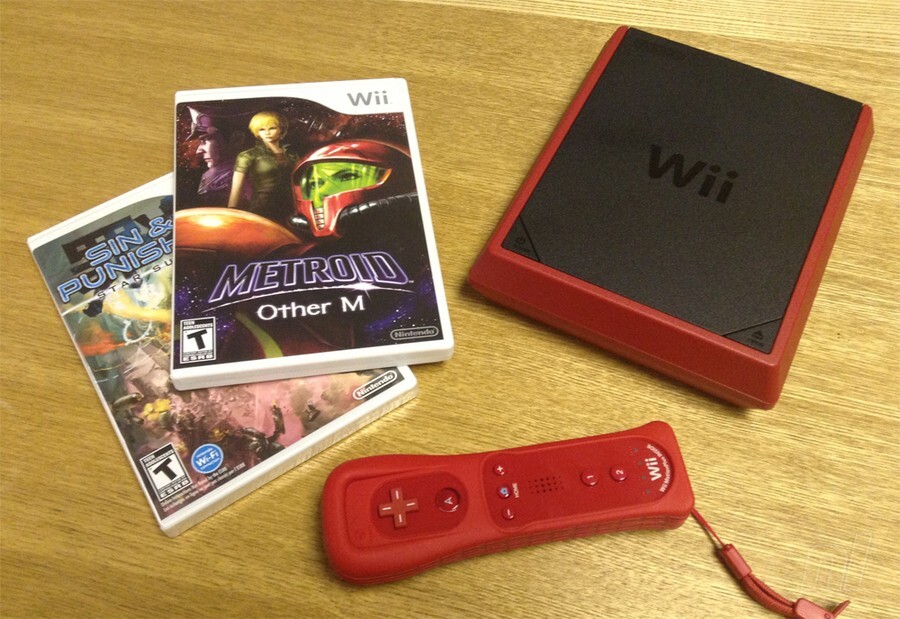
To say the Wii Mini's announcement was something of a surprise is an understatement. Having just launched the Wii U you would have assumed that Nintendo would want to focus all of its attention on its next-gen system and not risk any other hardware-based distractions. Strange timing aside, the Wii Mini is now a reality - and we've been spending some quality time with one to give you some impressions.
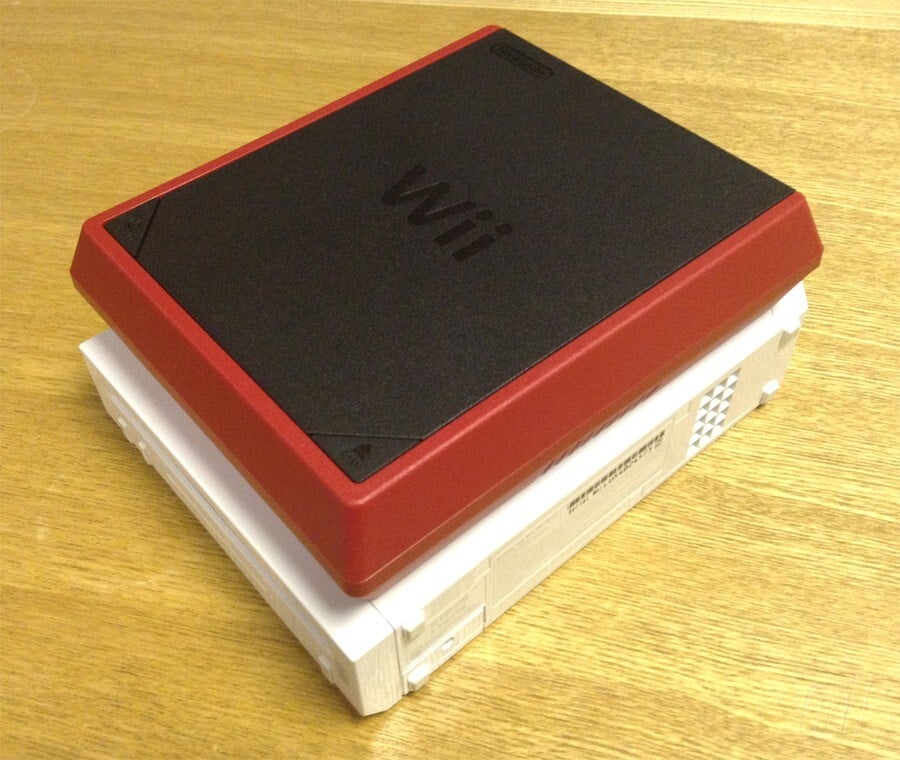
Although the name suggests a reduction in size over the original Wii, the Wii Mini isn't actually a great deal smaller than its predecessor. However, for some reason it does appear to be a little dinkier than the Mark 1 console - which probably has something to do with those angled corners. The Wii Mini is almost half the weight of the original, tipping the scales at 724 grams (the previous model was a much chunkier 1200 grams). As a result it feels a little cheaper and less dependable; there's clearly a lot of empty space inside that shell. The matte-finish casing is a nice deviation from the super-glossy Wii and Wii U designs, and means it won't collect unsightly fingerprints in the same annoying fashion.
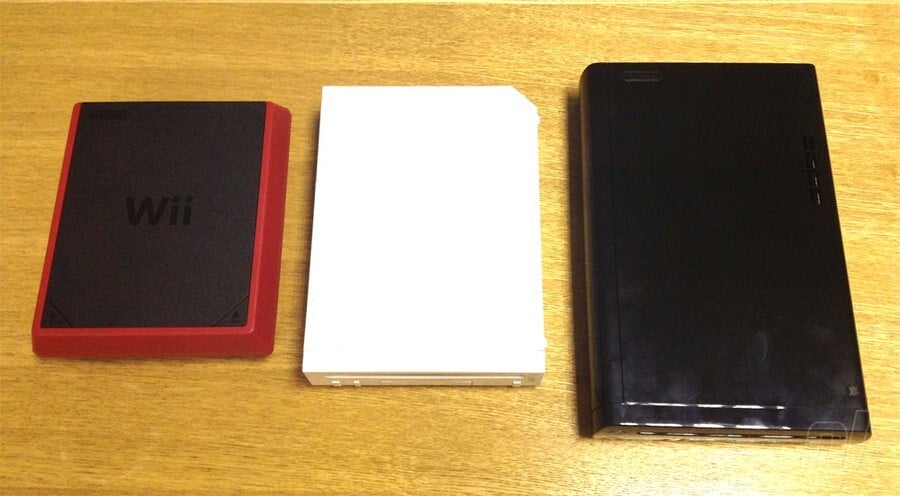
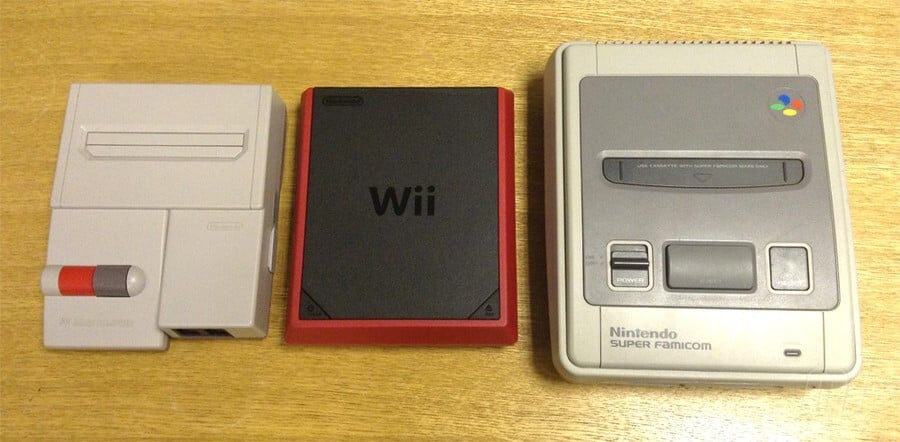
One of the cost-cutting measures Nintendo has employed is the introduction of a top-loading disc drive. This gives the console a similar appearance to that of an old-school portable CD player, and it lacks the premium feel of the original Wii's illuminated front-loading drive. When the disc is in place and being read by the system it can get quite noisy, but no more so than its forerunner. A fan is situated on the rear of the console to control internal heat, and that emits a low-level hum. There are no GameCube controller ports, which means the console has no backwards compatibility, and the SD card slot has also been removed.

As has been widely reported, the Wii Mini lacks online connectivity. If you go to the page in the settings menu where the "Internet" option usually resides, you're faced with a blank space. The USB port on the rear of the console hints at potential expansion, but don't get any ideas of hooking up a USB Ethernet adapter - while we've not tested it personally, we've heard reliable reports that it doesn't work at all. Strangely, Nintendo hasn't given the console a unique menu to reflect the absence of online features - you basically get the exact same interface that is present on the standard console. This means having your usual grid of channels, all but three of which are entirely blank on the Wii Mini.

The disc channel, Mii channel and Wii Guide channel are the only things you'll get to play with here, although the fact that you can edit channel data in the settings menu hints that there could to be some way of installing new ones via physical media in the future. Some games - such as Wii Fit - create their own channels, but these are few and far between. One would hope that Nintendo is preparing some disc-based compilations of popular WiiWare and Virtual Console games, but a more likely explanation is that it was just too lazy to overhaul the existing Wii menu for this new system. Transferring existing software is also impossible as the Wii Mini doesn't have an SD card slot.
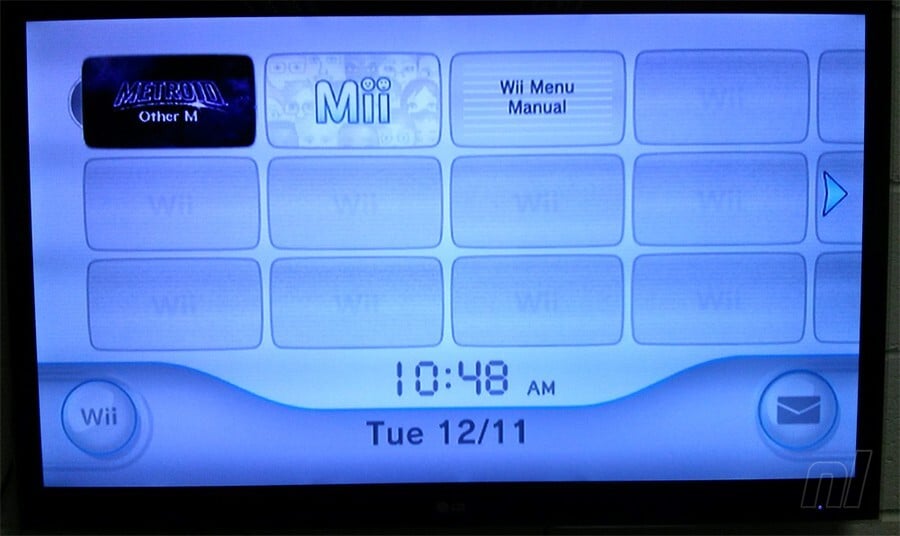
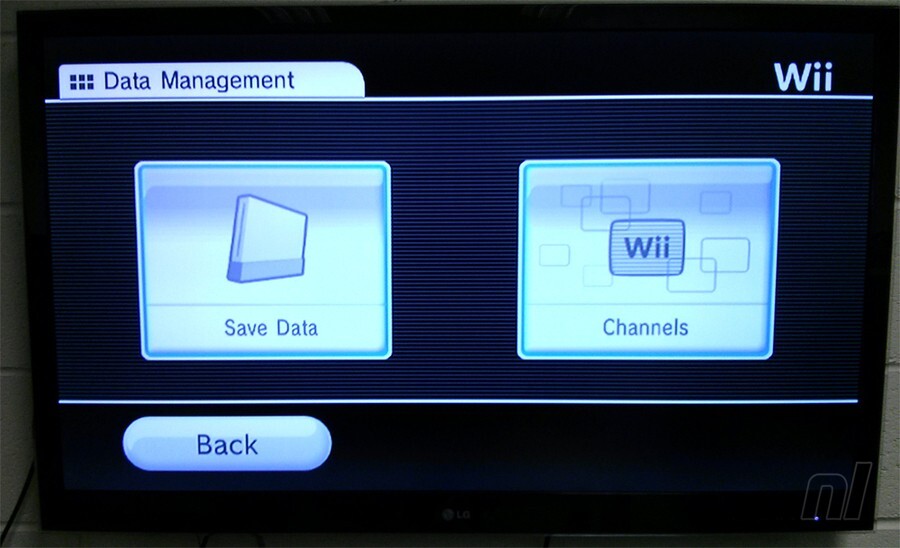
The red Wii Remote and Nunchuk bundled with the console are a welcome bonus; the Wii Remote includes MotionPlus and comes with its own rather fetching red silicone jacket. Out of the box the Wii Mini ships with a standard composite AV cable, and the image quality afforded isn't fantastic. Visuals are fuzzy and colours appear washed-out, but unfortunately there's nothing you can do to remedy these shortcomings - the console is incompatible with component cables and therefore lacks 480p support. We tested it with our standard Wii component lead and couldn't get a picture to output to the TV. This drawback severely curtails the Wii Mini's appeal to dedicated players; having to endure soupy, ill-defined visuals makes enjoying many Wii games harder than it should be - especially if you're playing on a large-screen TV.
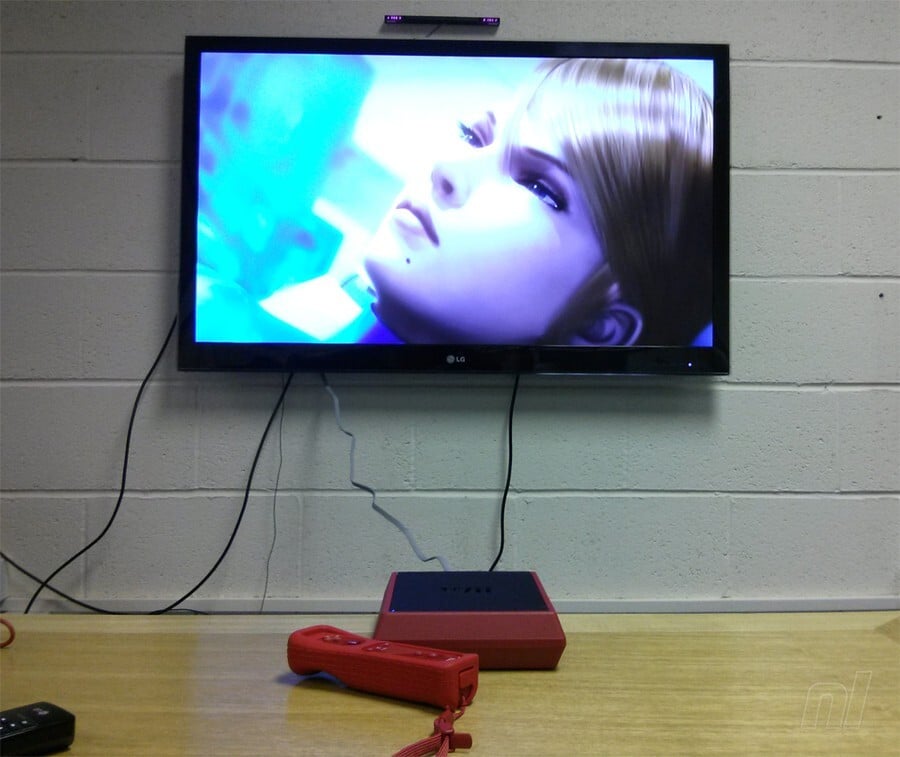

So there you have it - the Wii Mini is, as we were largely aware - a scaled-down version of Nintendo's best-selling system. The lack of online connectivity and removal of support for component AV are going to be insurmountable negatives for dedicated players, but you have to remember where this console fits in the grand scheme of things; it's unlikely that many hardcore Nintendo fans are going to be looking into buying a Wii now - what with the console being six years old and the Wii U being available - but for casual players who simply want to play all the popular titles, this $99 package makes a little more sense. Even so, you have to ask yourself if it's not a better idea to simply pick up a Mark 1 Wii on the cheap - with over 100 million systems out in the wild, it's not as if they're expensive or hard to come by these days.




Comments 115
Meh! Collectors item for Sheldon cooper...
Hmmm.. they won't sell a whole lot of these.. nice for the system collectors.
The Wii Mini is a kinda cool idea in principle, an old school style gaming only console but with the addition of a cool motion controller (Nothing more. Nothing less), but it just seems like Nintendo half-a**ed it a bit.
expensive, seeing as, on average, there's a wii bundle with a game you'd like for similar pricing if you add the game to its costs.
Fail, imo. Oh well, wiiU yay!
Wow, I didn't know it doesn't even support component, that's quite odd.
Obviously I'm not getting one, and it's even more obvious who this Wii is targeted towards.
Perhaps Ninty just really wanted a new console to push Wii sales over that 100 million
It looks nice,and it'll be quite the collectors edition in year to come.
But I still think Nintendo pushed this out to help the numbers of Wii sales reach 100 million before the years out.
What was the point for this console anyway? (serious question)
@JustYourAverageBleh To clear a Canadian warehouse of spare Wii parts most likely.
What a piece of trash. Simply awful. Hope this thing dies soon.
Might get for my little cousins if it comes to the US.They don't need to be playing online anyway.
Wii Mini meant stripped, not small.
The worst thing about this? They used Other M to test it.
I still can't wrap my head around the purpose of this thing. Actually I can't find the purpose at all.
What about the downloadable patch for Zelda: Skyward Sword? Not happening for on this system.
http://www.youtube.com/watch?v=X8TDfAfXacE
just pretend you dont have any form of internet when playing this
So this is the Wii Minimal rather than the Wii Miniature. Removing component support is the most killer of all. At least with no SD and no Internet, I could probably still have found some use for this, but forcing people to use a shoddy video connection is ridiculous. They should have given people the option to still buy a regular Wii, but it looks like the only options we'll have in Canada from now on are this or the Wii U. Apparently, Nintendo really wants to force our hand to buy the Wii U, and take advantage of anyone too poor to afford the Wii U by sticking them with this garbage.
Might just be the most pointless console downgrade (???) ever. Stripping it of gcube support and SD card might be forgiveable but the lack of any online capability is just baffling. I hope customers are being properly advised when purchasing this. Imagine little Timmy's face when he boots up Mario Kart Wii to play his Australian cousin. . . "sorry Timmy. One of the biggest console manufacturers couldn't be assed giving you an Ethernet port. . . or even Wifi ... ... In 2013????" I love Nintendo but all these oversights are beginning to add up. The new slim PS3 doesn't strip away important functions.
I wonder why the old Wii didn't have a top-loading disk drive?
I'm flummoxed by the people who are criticizing this as if it's the next-generation Nintendo console. This is not intended to be a full-fledged gaming console. It's for the extreme casual player just looking to tool around once in a while or perhaps for a real gamer to bring to a college dorm or place in a spare room.
@JustYourAverageBleh Money
"having to endure soupy, ill-defined visuals makes enjoying many Wii games harder than it should be - especially if you're playing on a large-screen TV."
YEAAHHHH, CAUSE THE ORIGINAL WIIS GRAPHICS AND VISUALS WERE SOOO AMAZING TO BEGIN WITH
Looks very cool. A very good idea for a vacation home or on the go. But I guess from the pictures above comparing it to that original white Wii, I just don't see how the whole "mini"is there. It looks the same size!!?
Next time you're fishing in northern Quebec, plug this bad boy in that 19-inch old color tube tv in the camper. That's all that its good for.
Does the Wii mini have a sync button? Out of all of the screenshots that I've seen, it doesn't look like it's anywhere on the console at all.
Does that mean that the only Wiimote that works with the console is the included red one?
What a waste of resources! This doesn't make any sense at all to release this now. Maybe as an option at launch but still its worse then a GameCube as is!
i think im going to wait for the inevitable wii mini 2
It's certainly a strange one. I could live without GameCube compatability, but removing all online functionality is a step too far, as it removes the ability to use Netflix, BBC iPlayer, etc.
If it was a redesigned RVL-101 with an ethernet port instead of Wi-Fi that would be fine (if increasingly less practical), but this is... a bit rubbish. Especially considering a used Wii with full functionality is around £60 these days.
Wii Mini and Other M are wastes of money. Way to put "two and two" together in this article!
After reading "no component video; no SD card" along with the stuff we already knew, I began to wonder if this was Nintendo's equivalent of "a laptop for every child" project. It certainly seems more of a third-world target-market, which beggars the question "Why Canada?"
Is it the result of some rather skewed market-research?
There is no incentive whatsoever that I can imagine to buy this over a pre-loved, unknobbled Wii, particularly at that price-point.
The score: Nintendo 0 - 2nd-hand market 1 .
Nobody should lose on their home turf...
"removal of support for component AV"
I was generally ok with the Wii Mini up until this point. The limitations were restrictive, but wouldn't really affect my ability to play retail games in the future so buying a "backup" console might've made sense. (Internet won't matter after servers get shut down. GameCube games can always be played on my GameCube console. Missing SD card support is unfortunate, but not a deal breaker.)
However, dropping support for component video is the straw that broke the camels back for me. Not only will the picture quality look worse, but the console will be restricted to TVs with composite input - something that is becoming increasingly less common on new sets. Will TVs have composite input at all in 5-10 years? I'm not keen on taking that bet.
it doesnt accept component cables?? WHAT?
It could better be announced like this:
"Buy a red wiimote plus and a red nunchuk and you get free a Wii disc reader."
@Luigifan141 Yeah it does - it's on the side.
In other news: people who hate on Other M confuse and befuddle me.
@ajcismo haha ça peut pas servir à autre chose ! Seriously.....I don't get why it's ONLY available in canada...99$ is too pricy for what it gives IMO.
I would have been happy to pay an extra nickel to get 480p
The lack of component output kinda confuses me. I mean, of course I dont like it, but why would that have been stripped out?
"Even so, you have to ask yourself if it's not a better idea to simply pick up a Mark 1 Wii on the cheap - with over 100 million systems out in the wild, it's not as if they're expensive or hard to come by these days."
Exactly why no one should buy this, not even low-income families.
The system looks like it was pulled right out of the early 80s, which is kind of cool in its own way, but overall this thing is a piece of junk.
The only thing that looks good about this is the poptop. Everything else looks like garbage.
Seriously, though, poptops >>>> disc trays/everything else.
Looks awesome! Shame it isn't!
I changed my mind.
I no longer want it.
Reason 1- No SD Card slot.
Reason 2- No Component Cable support.
I understand the goal of this console. It's funny that when a console does nothing but play games nowadays, people think it's trash. And it's not like it's being sold at a real high price, either.
@Damo #38 - I know what you mean.
@True_Hero It's not about it only playing games really, imo. It's that, at the price they are putting it at, it still seems a bit overpriced considering that they've pretty much stripped it of EVERYTHING even half useful.
From the comparison, it doesn't really seem 'that' mini so they could've at least thrown in Gamecube bc or some other little extra to make up for it's nakedness and no internet/access to VC/Wiiware(we can only hope at this point that they are working on something related to that last issue).
It's really not that bad considering that the Wii remote and Nunchuck alone would cost you $60.
So this console doesn't support component cables.
But what about RGB cables?
I usually connect my Wiis, Gamecubes, PS2s and XBOXes via RGB (scart) to the LCD-TV and the picture quality is absolutely fine. No component cable needed.
@Chriiis
Agree that value just doesn't seem right with this console. Even when you consider that a Wii remote/nunchuck combo accounts for much of the cost, it's still an underwhelming value proposition after Nintendo stripped out every non-essential bit of functionality.
They should have at least preloaded Wii Sports and/or Wii Play on the system, taking up some of those empty menu spaces in the process. It's not like that would cost them anything, and it would make this a pretty attractive games box for kids/families.
@mudjo On the bottom of the Wii mini it reads "Model RVL-201 (USA)."
Keep in mind that this is not Nintendo's new console. This is just a final iteration of the Wii (as far as I know ). As for the target audience of this device, this might make that clearer. This article also seems to suggest that it is still only available in Canada. One final thought, no one is making you buy it. Hope this helps.
@Ideal_Hero It has next to nothing to do with 'no one is making you buy it'; I personally like the color choice and retro feel, I was just hoping that, since online is non-existent(cutting out VC/Wiiware currently), they would have something thrown in that would somewhat make up for that(looking at the size comparison, GC bc could've been a possibility without adding much bulk).
Who's to say I wasn't genuinely interested before?
@Chriiis - That was a general statement. It wasn't directed at anybody in particular. Sorry if it felt like I was targeting you or something. I agree about the look of the console though. It does look nice and retro.
@Ideal_Hero No offense taken; I was just bringing up that not everyone is in the usual 'I ain't buying!!!" mode(where the 'no one is making you buy it' would apply better), just a bit confused why they would cut out VC/Wiiware/GC bc possibilities, etc. when they were also huge attractions and wouldn't have added much bulk(although the mini isn't that much smaller to begin with).
No component. No SD cards. No online. No GameCube support.
So, you're left with a Wii with even crappier graphics that doesn't allow you to play online multiplayer and cannot transfer data in any way. It also can't play GC games. Yet, it costs almost as much as a bundle on sale which normally includes a game or two. Well, I guess it's probably cheaper to produce. :/
@Chriiis - If they had at least left access to the WiiWare shop and kept the SD card slot, the Wii Mini would have been excellent, imo, for those who just want to play games and who don't care about online. Oh well, hopefully this is what someone is looking for.
@Metabble_King
Nobody said it can only play single player games. Why do you make that assumption?
I wonder if this supports S-Video as that would be a little better than Composite, still much worse than component.
It's a nice-looking system. If I were just into collecting consoles, or if I didn't already own a Wii, this would be pretty cool to have. It's like a little piece of art, in a way... or maybe it just seems that way because the Wii and WiiU designs are so bland. Yup, I said it.
@mudjo I noticed that also... does that mean it's now available in the US N/A regions?
@ejamer Sorry. By that I meant "can't play online multiplayer" which of course isn't the only type of multiplayer.
@Metabble_King it really seems like they 'phoned this one in'.
The Super Mario Bros red Wii looks a lot better in my opinion.
@DarkEdi never thought of it that way but you're right.
what baffles me most of this, is with all important things stripped out, they offer it in such a (relatively) small market.... one small area of the world... how is that supposed to attract sales? is there some secret memorandum somewheres that states that Canadians now are gaga for things small, red and useless? wow talk about self sabotage. N did it.It's the GB Micro all over again... I guess they really don't learn...
...just no
At the least, does it even have an HDMI port?
It just keeps getting worse. It doesn't even do 480p. There are cheaper 1080p upscaling DVD players with HDMI ports, and the WiiMini can't even use component. I feel sorry for who ever gets this for Christmas.
well i will pick it up sometime later next year as a collectors item or as a backup in the future, i never really went online on the wii anyways as from experince it wasnt that great so this doesnt effect me
Lack of component video is shockingly horrible. Very poor show, Nintendo.
@Salnax You know, that may sound crazy, but I wouldn't be surprised...
Real shame about the lack of an SD card slot and GameCube controller ports.
@Scollurio I don't even think Sheldon Cooper wants that.
I don't even think Reggie wants that
"but unfortunately there's nothing you can do to remedy these shortcomings - the console is incompatible with component cables and therefore lacks 480p support."
Another kick in the balls from Nintendo. They want to cut a few pennies so they remove support for superior video output. I bought the SNES2 expecting to get S-Video support only to find that it wasn't implemented on that model. I boxed it up, threw it in the closet and bought a $5 used SNES from a local used media store.
despite it not having online and such, I really love the look of the system and will be getting it, and I live in Canada, so a nice lil exclusive thanks nintendo!!
@Kyhunsheo Nope.
I have a Wii mini and quite like it. I still play games on a big CRT TV, so I've never had to worry about component cables or input delay. (Never been a huge stickler for video quality) I never play games online on the Wii, and the Virtual console games I played the most on the Wii I can still play on Wii Mini due to Kirby's Dream Collection. SD card slot has never been an issue for the games I play either, and I've never once needed a Game Cube controller for my Wii.
I'm that one guy that the Wii Mini is suited for. I'll probably give my old Wii to my brother for Christmas. I'll start worrying about composite cables and such as soon as there are affordable modern TVs that fix the problems they have with playing games.
@Damo Same here!!! Why do people hate Metroid Other M so much! It is a great game, yes I said great, not good, GREAT! It may not have the replay value that some of the others do, but it awesome. The only bad thing (which is a small complaint) about the game is the annoying dialogue.
@PekoponTAS Thank you so much for being the only person who appreciates this device. I personally would love to have one! I have 2 Wii's already and I want one!
wow...this doesnt seem mini at all. Looks like the same size of the wii with those odd red edges...
Well at least it seems you can clean the lens easily this time
This thing...is useless. Nintendo should have left the original Wii alone.
I like my original with the SD card slot, GameCube ports, and Internet Access.
If I was going to buy a Wii for someone, it wouldn't be the Wii Mini.
@Kirk
More like quarter a**ed it!
It's not even much smaller. Whats the point then?
This is pretty much relpying to everything everybody said. its not smaller at all. and if it is, its barely smaller
Does the Wii Mini have the same number of memory blocks as the regular Wii?
Wow, first I've read about this not supporting component cables. Crazy. It's not like removing support for component/480p is saving them a ton of money, it uses the same port as the regular RCA 480i.
Nintendo - What did the Canadians ever do to you?
Wii Mini? I think "Wii 0.25" would have been more appropriate.
I smell Virtua Boy!
I'm Canadian, and I don't even understand what the purpose of the Wii Mini is.
It's only available in Canada,
It's Winter and Cold outside,
They called it Mini Wii.
Nintendo, I see what you did there..
This would be kind of OK if the regular Wii and the Wii U never existed. But, umm, Nintendo? They do exist Nintendo, they do...
Microsoft Canada: Releases console bundle with several games, bundle only available in Canada.
Nintendo Canada: Releases crippled console with no bundled games that nobody wants, not even Canadians.
@Coldheat I don't think you get the point of the Wii Mini. It's supposed to be a budget priced version of the Wii. At that I'd say they did well. You don't have to buy it.
It saddens me that most of the people on here don't get that the Wii Mini is meant as the ultra casual console..
I think I might drive the 100 mile trip north just to get one of these lol! But in reality, this would be pretty cool to buy just for the styling of it and the possibility of it becoming a collector's item..
@Cr1TiKaL It's $100 though. Regular retail price for a regular Wii with a $60 game and soundtrack is $150. If the Wii Mini is supposed to be "budget priced", they're selling it at the wrong price.
@MoRbidIty No need to drive 100 miles, just have it shipped.
I heard there's already been a recall. Nintendo forgot to add the disclaimer to the back of the box; WARNING: This product will lead to disappointment, sadness, envy of others, and buyer's remorse.
You know, Miyamoto originally wanted the Wii to cost $100, but memory and "other pricey parts" kept that from happening. http://kotaku.com/215349/miyamoto-i-wanted-wii-to-cost-100
Anyway, thanks for the hands on Damo.
@Gridatttack Yeah I said the same thing, but now when I think about. When half of the machine pops open, that is a lot more spaced that wasn't used in comparison to the original (Not as much innards) And when you compare it to the NES top loader it really puts it into perspective, because I have an NES top loader and those things are puny!
Is there somewhere on the internet you can buy these?
p.s I live in the U.S.
Other M rocks.
This Wii Mini is crazy. Maybe the Wii Mini was 'cloned' from a regular Wii, and the Wii warned it of danger, but it didn't listen... I bet someone will put a regular Wii inside of that case now. Good project.
"Wii?" More like "Why?"
@HawkeyeWii https://www.thesource.ca http://www.futureshop.ca http://www.bestbuy.ca https://www.amazon.ca and http://www.ebgames.ca don't. http://www.sears.ca does - but they don't have the actual Wii or Wii Mini console listed on their site. https://www.toysrus.ca allows you to use a U.S. Billing Address, but forces you to ship to a Canadian address. Honestly, your best option might be http://www.ebay.com or a similar site. There's likely to be a markup on the price, but if you really want one...
You know what i think is more useless? All these comments from people who this doesnt effect. Chill out.
@krunchykhaos This affects all of us. If people actually buy the Wii Mini, it will give Nintendo the message that there is actually a market for this type of thing - which there isn't.
@Coldheat lol, wut? If people buy it, of course there is a market for it!
@Kagamine I'd like to hope the typical Canadian is an educated shopper. If this thing sells though, I may be proved wrong.
Mini Moose approved
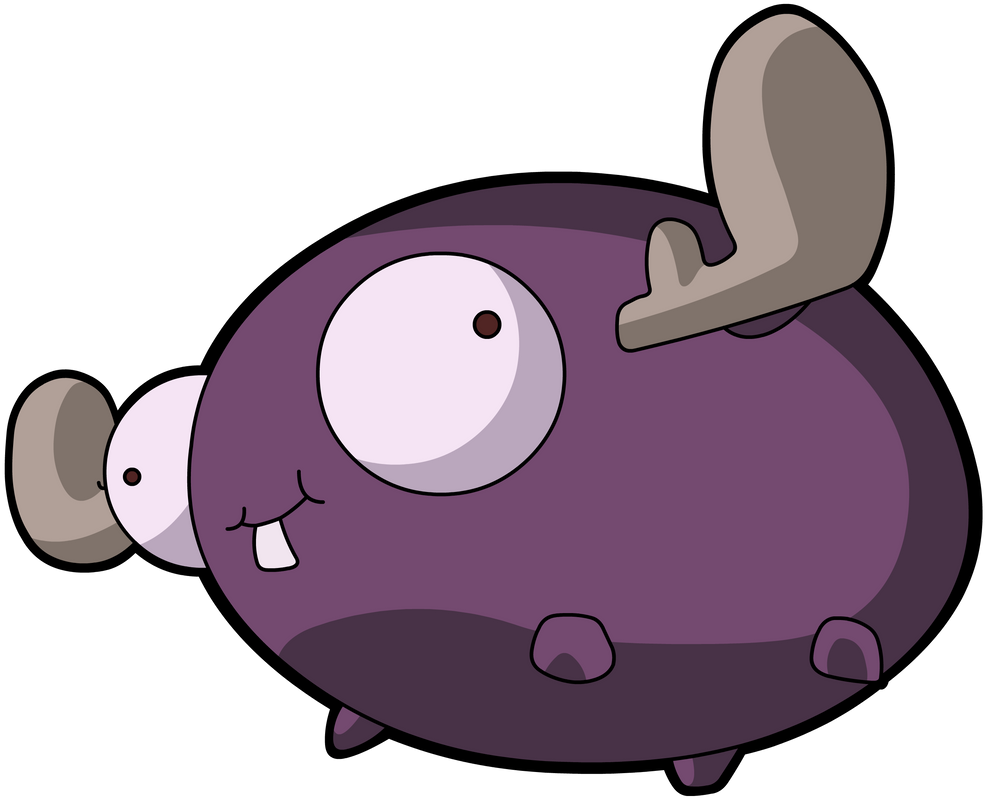
@Damo
Same here friend.
@ajcismo "Next time you're fishing in northern Quebec, plug this bad boy in that 19-inch old color tube tv in the camper. That's all that its good for."
Better yet, tie it to your line and see if you can attract a Cheep-Cheep.
I don't get why people are complaining about the Wii Mini...no one is forcing you to buy one! I just hope that Nintendo continue to sell the traditional model alongside the Mini because I would always recommend that over this, even with the price difference!
The only thing I don't like about this console was that there is no auto load option so that the Wii Mini could load the game immediately upon turning on the console like the old systems. Instead even w/o online and all those fancy channels, we are still force to get through the empty Wii menu first before playing a game. I know there could be time when you may need to go to the System setting and change a few things but c'mon there's a Home button, we could always exit a game to the Wii menu whenever we want anyways.
If you live in Canada, and need another wii remote plus/nunchuk ($60), this may be a decent deal (with an extra Wii for another room). If you're living on a fixed income, and have one of those bargain HDTVs with a component hybrid (component or composite) input, and don't mind buying used Wii game discs.
It doesn't appear that that they're flying off the shelves, if they're priced at $89.99* retail vs $99.99 MSRP. Reduced price may be due to retailers competing for holiday shoppers.
*Source: Shoppers Drug Mart according to this YouTube video review/comments: http://www.youtube.com/watch?v=kt-XGx_B3tc
The red and black reminds me of the Virtual Boy and that's not a good thing. Why this console is doomed is because the original Wii is so popular that there are TONS of used ones available. EB Games sells them for $79.99 in Canada and local pawn shops in my area sell them for $50-70. Why buy a severely limited Wii Mini when you can buy the real deal for less. Sure it's used but it gives you the complete Wii experience on the cheap.
@eigafan Where have you seen the Wii Mini being sold for only $90 or $80?
@Omega Not likely. The NTSC exclusive SNES mini didn't support RGB. Neither does NTSC Gamecube, or NTSC original Wii officially (though a softmod to PAL should switch video outputs to RGB).
@Lum Really? Neither the Gamecube nor the Wii support RGB video output? I can't believe this. That would mean that there are no RGB scart cables for the Gamecube/Wii on the market in america?! (In Europe, this is the preferred way to connect older consoles to CRT TVs.) That's strange. I didn't knew that.
While I still think it's a strange decision, I must admit that it does look nice! And I like the lid! Gamecube had also one!
I can see this becoming a collectors-item, but I don't know if the Canadian masses will buy it! Also, I expected it to be much smaller (as everyone else)!
Nintendo Wii Mini review
"We never quite bought into Nintendo's announcement that the Wii Mini would be Canadian exclusive - these console revisions aren't cheap and we assume that the platform holder will roll out the new hardware in other territories in due course. But having spent some time with the Mini, it's safe to say that we'd be quite happy if Nintendo never releases it elsewhere."
http://www.eurogamer.net/articles/df-hardware-nintendo-wii-mini-review
The console does not look good, does not look any better than the original console.
And I see there being no point in getting this, Is there really a size difference between this and the original?
I would not consider wasting $100+ towards a Wii Mini when you could be getting a Wii U
I bought one of these, Technically you're not wasting $100. If you buy this thing, you're wasting $35. Although mine was bundled with Mario Galaxy for free, which made the system itself worth $15-20 in my eyes. The red remote plus+ nunchuck alone is worth $65 if you had to buy a new set, nevermind the fact having the limited edition red color.
What pisses me off is the composite connector. It's 2012, you can buy a 720p TV for less than 500 dollars. How the hell can they release something without the component connector. If it is suppose to play Wii games only, shouldn't it at least do that properly? Overall Nintendo is ... Least the remote plus isn't made of cardboard.
Not going to get this , no how no way....that said, GOOD LUCK to those who get it !!
I'm actually insulted at how shoddily Nintendo has clearly thrown this thing together.
I mean to not even redesign the main menu so there's not just a whole screen of empty "Channels", in fact multiple screens if you scroll to the right, is just disgusting.
They've just chucked this thing together and put it out there to make a quite buck off ignorant consumers and I find it disgusting.
This is not the Nintendo I loved and respected growing up.
I'm actually insulted at how shoddily Nintendo has clearly thrown this thing together.
I mean to not even redesign the main menu so there's not just a whole screen of empty "Channels", in fact multiple screens if you scroll to the right, is just disgusting.
They've just chucked this thing together and put it out there to make a quite buck off ignorant consumers and I find it disgusting.
This is not the Nintendo I loved and respected growing up.
i assume that the channel editor is for games with custom install channels, like mario kart wii and its mario kart channel, or wii fit and its wii fit channel
that said, if people can hack the NES classic edition, then people can definitely hack the Wii Mini
Show Comments
Leave A Comment
Hold on there, you need to login to post a comment...